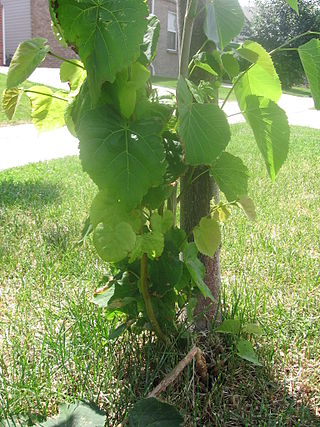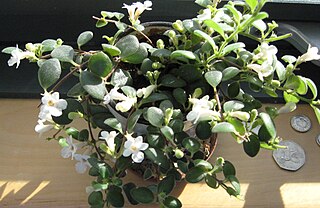
In botany, a bud is an undeveloped or embryonic shoot and normally occurs in the axil of a leaf or at the tip of a stem. Once formed, a bud may remain for some time in a dormant condition, or it may form a shoot immediately. Buds may be specialized to develop flowers or short shoots or may have the potential for general shoot development. The term bud is also used in zoology, where it refers to an outgrowth from the body which can develop into a new individual.

Aerial roots are roots above the ground. They are almost always adventitious. They are found in diverse plant species, including epiphytes such as orchids (Orchidaceae), tropical coastal swamp trees such as mangroves, banyan figs, the warm-temperate rainforest rata, and pohutukawa trees of New Zealand. Vines such as common ivy and poison ivy also have aerial roots.

Monotropa hypopitys, the so-called Dutchman's pipe, false beech-drops, pinesap, or yellow bird's-nest, is a herbaceous perennial plant, formerly classified in the families Monotropaceae or Pyrolaceae, but now included within the subfamily Monotropoideae of the family Ericaceae. It is native to temperate regions of the Northern Hemisphere, and is scarce or rare in many areas. However, it is still the most widespread member of the subfamily. While currently included in the genus Monotropa, recent genetic evidence strongly suggests that Monotropa hypopitys should be placed in its own genus, Hypopitys, with the single species Hypopitys monotropa Crantz, but possibly containing several other species.

Anubias is a genus of aquatic and semi-aquatic flowering plants in the family Araceae, native to tropical central and western Africa. They primarily grow in rivers and streams, but can also be found in marshes. They are characterized by broad, thick, dark leaves that come in many different forms. The genus was revised in 1979 and since then its nomenclature has been stable. Species can be determined by using mostly characteristics of the inflorescence. Because of the often shady places where the plants grow, the genus was named after the Egyptian god Anubis, the god of the afterlife. The genus was first described in 1857 by Heinrich Wilhelm Schott, with A. afzelii as its type species.

Echinodorus tunicatus is a species of aquatic plants in the family Alismataceae.

Echinodorus berteroi is an aquatic plant species in the Alismataceae It is native to the southern and central parts of the United States, as well as Central America, the West Indies, and South America as far south as Argentina.

Basal shoots, root sprouts, adventitious shoots, and suckers are words for various kinds of shoots that grow from adventitious buds on the base of a tree or shrub, or from adventitious buds on its roots. Shoots that grow from buds on the base of a tree or shrub are called basal shoots; these are distinguished from shoots that grow from adventitious buds on the roots of a tree or shrub, which may be called root sprouts or suckers. A plant that produces root sprouts or runners is described as surculose. Water sprouts produced by adventitious buds may occur on the above-ground stem, branches or both of trees and shrubs. Suckers are shoots arising underground from the roots some distance from the base of a tree or shrub.

Wachendorfia is a genus of perennial herbaceous plants that is assigned to the bloodroot family. The plants have a perennial rootstock with red sap. From the rootstock emerge lance- or line-shaped, sometime sickle-shaped, pleated, simple leaves set in a fan, that are flattened to create a left and right surface rather than an upper and lower surface. The leaves die when the seeds are shed in three of the species, and are perennial in one species. The rootstock also produces flowering stems annually that carry a panicle of zygomorphic, yellow or yellowish flowers in two distinct forms, one with the style and one stamen bent to the right and two stamens to the left, and vice versa. The fruit opens with three valves and each contains a single, hairy seed. All species only occur in the fynbos biome in the Cape Provinces of South Africa.

Senecio eboracensis, the York groundsel or York radiate groundsel, is a flowering plant in the daisy family Asteraceae. It is a hybrid between a native and a non-native introduced species, which naturalised in England but the population failed to sustain itself. It was brought back by captive cultivation. It is a self-pollinating hybrid species of ragwort and one of only six new plant species to be discovered in either the United Kingdom or North America in the last 100 years.
Important structures in plant development are buds, shoots, roots, leaves, and flowers; plants produce these tissues and structures throughout their life from meristems located at the tips of organs, or between mature tissues. Thus, a living plant always has embryonic tissues. By contrast, an animal embryo will very early produce all of the body parts that it will ever have in its life. When the animal is born, it has all its body parts and from that point will only grow larger and more mature. However, both plants and animals pass through a phylotypic stage that evolved independently and that causes a developmental constraint limiting morphological diversification.

Codonanthe is a genus of mainly epiphytic plants in the family Gesneriaceae, endemic to the Atlantic Forest of Brazil. The botanical name comes from the Ancient Greek for 'bellflower'. They have white or pale pink flowers and somewhat fleshy leaves. In 2013, the genus was reduced in size when more than half of the species were transferred to Codonanthopsis. They can be grown as houseplants, particularly in hanging baskets. Artificial crosses with Nematanthus hybrids have produced the hybrid genus × Codonatanthus.

Vanilla polylepis is a climbing orchid species in the plant family Orchidaceae. It is native to tropical Africa, with a range spanning the width of the continent, from Kenya to Angola. It grows in high-altitude evergreen and swamp forests between 1,200–1,500 m (3,900–4,900 ft) and is often found growing on trees bordering rivers and waterfalls. Plants produce bright green, fleshy stems, 10–12 mm (0.39–0.47 in) in diameter, with large, glossy leaves. White, aerial roots form on the stems allowing the orchids to attach themselves to trees for support. As with many orchids, they produce showy flowers, which in the case of V. polylepis are white and yellow with a pink to maroon blotch. This differentiates them from similar species. They have seedpod-like fruits, called capsules, which produce a distinctive aroma as they dry. They are closely related to the well-known species Vanilla planifolia, whose seed pods are used commercially in the production of vanilla flavouring.

Fieldia australis, usually referred to as fieldia, is a small climbing plant or epiphyte found in eastern Australian rainforests. Commonly seen in the cooler rainforests at higher altitudes. It also grows in the warmer rainforests with a high humidity. The plant uses adventitious roots to grip hold of tree trunks, mossy rocks or tree ferns.

Austrocactus coxii is a plant species in the genus Austrocactus from the cactus family (Cactaceae), indigenous to southern Argentina and southern Chile. It grows as short columnar stems up to 5 cm diameter, reaching 60 cm in height, with 6-10 tuberculate ribs. Central spines are hard, straight or slightly hooked, light brown to whitish and up to 4 cm long. Thin spines are interwoven and range from 6 to 10 in number; each is up to 1 cm long. Its diurnal red flowers are up to 3.5 cm in diameter.

Tempskya is an extinct genus of tree fern that lived during the Cretaceous period. Fossils have been found across both the Northern and Southern hemispheres. The growth habit of Tempskaya was unlike that of any living fern or any other living plant, consisting of multiple conjoined dichotomous branching stems enmeshed within roots that formed a "false trunk".
Calectasia pignattiana, commonly known as the stilted tinsel lily or Pignatti's star of Bethlehem, is a plant in the family Dasypogonaceae growing as a perennial herb and is endemic to the south–west of Western Australia. It is only known from ten locations, four of which are on road verges. The species is classified as vulnerable.
Eowellerites is genus of ammonoid cephalopods belonging to the Welleritidae family. Species belonging to this genus lived in middle Pennsylvanian (Moscovian). Its fossils were found in USA and Japan. It had thinly discoidal shells with a quite wide umbilicus (U/D = 0.3 - 0.5). While in juvenile stages (up to 15 mm in diameter) venter is moderately rounded, it becomes slightly rounded to flattened when becoming mature (100 mm in diameter). 12-lobed suture has adventitious lobe on the first lateral saddle and is also characterized by an addition of an umbilical lobe. Sutural formula is (V1 V1) L1 L (U1 U2): I D. It has evolved from Winslowoceras henbesti and gave rise to genus Wellerites.

Zamia integrifolia, also known as coontie palm, is a small, tough, woody cycad native to the southeastern United States, the Bahamas, Cuba, and the Cayman Islands.

Diploprora truncata is a species of orchid native to East Himalaya and Thailand. Despite its placement within the genus Diploprora, it has been reported to be more closely related to Malleola baliensis, which is a synonym of Robiquetia aberrans (Schltr.) Kocyan & Schuit, than to the type species of the genus Diploprora championii. Thus, the genus is polyphyletic. The epiphytic plants have pendulous, monopodial stems, which bear distichously arranged, lanceolate leaves, which form sheaths around the stem. The widely spreading flowers are produced on lateral, laxly several flowered inflorescences.

Phalaenopsis honghenensis, also known as 红河蝴蝶兰 in Chinese, is a species of orchid native to Southeast China and Vietnam. The specific epithet honghenensis refers to Honghe, China.

















